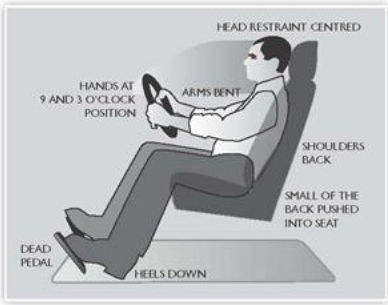10 Tips to Remember While Driving in the Rain
![]() It’s amazing what rain can do to the brain. When laying in bed, it can serve as the perfect sleeping aid. On the road, however,
It’s amazing what rain can do to the brain. When laying in bed, it can serve as the perfect sleeping aid. On the road, however, it flips on our fight-or-flight switch, keeping us in a frantic state when our safety depends on remaining calm. We can’t speak for everyone, but a lot of drivers go into panic mode at the sight of precipitation. That’s why we’ve written these reminders to take the stress out of driving in the rain. It won’t cure an inborn tendency to overreact in wet weather, but it will give you some pointers on how to maximize your safety.
it flips on our fight-or-flight switch, keeping us in a frantic state when our safety depends on remaining calm. We can’t speak for everyone, but a lot of drivers go into panic mode at the sight of precipitation. That’s why we’ve written these reminders to take the stress out of driving in the rain. It won’t cure an inborn tendency to overreact in wet weather, but it will give you some pointers on how to maximize your safety.
Lights
![]()
First off, make sure all your lights work – brake lights, headlights, taillights and turn signals – all of them should blink or shine when activated. Dull lights need replacement. As for your fog lights, use them sparingly. Both rear and front fog lights can blind drivers, and you should only switch them when you can’t see more than a 100 meters ahead of you.
Braking
![]()
Brakes can be your lifeline or a deathtrap, depending on how you use them. Avoid hard braking. Gentle tapping of the brakes will reduce the risk of hydroplaning, the sliding of your car on a wet surface that occurs despite you stopping. Also, make sure to brake a little earlier than normal since it takes longer to stop on wet surfaces. Finally, have your brakes tested if you have passed the manufacturer’s recommended schedule date, or if you hear high-pitched squealing while braking.
Steering

Get a good grip on steering! It’s a skill you need to master, especially for sharp turns, skids and sudden moves from other drivers. When it comes to skids, remember to STEER IN THE DIRECTION OF THE SKID, NOT AGAINST IT. As for sharp turns or evasive maneuvers, turn the wheel lightly, not hard. Your car is more responsive than you think.
Wipers
![]()
Using wipers take little effort on your part. As long as the motors work and you keep them at the right speed, you’re golden. However, you should check the state of your blades and replace them every 6 – 12 months. This is vital if the wipers leave streaks on the windshield, or if the motor turns too slowly. There’s no room to mess with visibility while driving in the rain.
Speed
![]()
Driving too fast on already wet surfaces is one of the main reasons why rain increases accident rates. So make sure to slow down. It’s wise for you to drive at the speed limit or slightly below – perhaps 10 km/h slower – for smoother and faster braking if a car ahead of you suddenly stops. Also, reduce your speed when making turns on slippery roads to prevent losing control.
Defrost
![]()
Heavy rainfall tends to stir up thick fog. Since it reduces visibility, it’s a good idea to turn your defroster on if your windows get too foggy. Much like your wipers, it takes no effort to use besides pressing a button. However, it’s a good idea to have your defrosting unit checked if you’ve noticed that it doesn’t clear up your windows fast enough. As mentioned before, further reducing low visibility isn’t a chance you want to take.
Road
![]()
Apart from driving, your focus belongs on the road. That means observing the road ahead, staying clear of the usual potholes and road fissures, but more importantly, flooding. Driving through flooded sections of road is damaging to your brakes, electrical components, engine, transmission and more. If you can’t overtake the oncoming lane to avoid a standing pool of water, you’ll have to drive very slowly through it. If it’s deeper than six inches, you will have to turn around and find another route.
Distance
![]()
You know not to tailgate in dry weather, so it’s essential to keep some distance between you and others in the rain. Remember, it takes longer to brake on wet roads. If you’re speeding behind a car that suddenly brakes, you might not stop in time and collide with them. Watch out for the sides as well. Some drivers have difficulty checking their blind spot in rain and fog, and they may drift too close to you.
Cruise
![]()
NEVER, should you drive in rainy weather with cruise control on! Here’s why: in cruise control, your car maintains a constant speed, which may not be suitable for wet roads. You can easily disengage it by hitting the brakes, but the travelling speed of a car in cruise mode could be too fast to slow down from in time (even if it’s just a second). This is worse if you’ve already started hydroplaning.
Tires
![]()
Tire safety plays a major role in driving in the rain, but you have to address it before moving. First, get your tire treads inspected – they’re your first line of defense against wet roads. And there’s also your tire pressure. Inflate it to the measurement (PSI) your manufacturer recommends, so that they’re no over or under inflated.
Calm During the Storm
For many of you, driving in the rain or bad weather in general, can feel nerve-wracking. That’s understandable. However, if you practice the right safety habits, you can greatly minimize the risk of having an accident. Many weather-related accidents occur because drivers were ill-prepared to handle a scenario that was quite preventable. And the consequences are often serious and sometimes tragic. To avoid these accidents, you should ensure that all of the above-mentioned car components are functional, and that your driving techniques are ready for the road. Your confidence to drive in wet weather will strengthen if you do.




